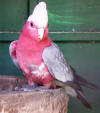. Galah

Aviary Notes: Level Of Knowledge Required: Beginner / Intermediate / Advanced / Specialist Breeders Only. Government Regulations & By-Laws: Refer to " Government Laws " web page. Housing Requirements: Refer to " Housing Birds " web page for general details on the housing of Cockatoos or read on for specific details for this parrot. An aviary of 4 metres long will allow these birds to be able to get adequate exercise. The aviary should be about 1.2 to 1.5 metres wide and about 2.1 metres high. Heavy gauge wire is necessary, preferably galvanized weldmesh. An aviary of up to 6 or 7 metres long is ideal. To help relieve boredom and as a way of providing exercise, suitable bird toys can be placed in the aviary. Most bird toys are designed to be chewed up and will require replacing after the birds have reduced them to splinters. Aviary breeding birds will enjoy playing with and destroying bird toys just as much as pet birds. Suitable non-toxic leafy branches can be placed in the aviary for the birds to chew up. This will entertain the birds, help minimize boredom and give the birds some beak exercise. Natural branches can be used for perches. These natural perches will be chewed by the birds and may need to be replaced regularly. A pet or companion bird kept in a cage will require a period of regular time outside the cage so they can get adequate exercise and maintain good health. Diet / Feeding: Refer to " Feeding Birds " web page for general details on the feeding of Cockatoos or read on for specific details for this parrot. Unlike many of the cockatoos, the Galahs in the wild mainly feed on the ground eating seeds, insects, fruits and vegetable matter. In grain growing areas and farms it will eagerly consume spilled grains. In the aviary the birds spend a lot of time on the ground. As the Galah is prone to being overweight or obese, an aviary diet should restrict the amount of Sunflower and safflower seed. Other seeds can include canary, corn, hulled oats, millet, milo, and wheat. A quality commercial "small parrot" or parrot seed mix is commonly fed. Other foods can include apple, almonds, peanuts, vegetables such as broccoli, corn, peas, endive and silverbeet. Leafy green vegetables are essential to a balanced diet. Small amounts of Plain Madeira cake can be added to a balanced diet. Seeding grasses are eagerly consumed. Many will eat insects such as grubs and mealworm larvae, pupa and beetles. Dry dog food can be offered. Commercial Parrot pellets can make up part of a balanced diet. The seed pods, flowers and fruiting bodies on native trees such as eucalypts are eagerly consumed. These items provide exercise and entertainment as well as some nutritional value. Nesting: A basic overview only. Dimensions are typical / average and can vary widely, influenced by the owner's preferences and the birds preferences. Parent bird's preferences can also be influenced by the size and type of nest-box / log in which the bird was hatched and reared. If space allows, offering a choice of sizes and types of logs or nest-boxes, and placed in various locations within the aviary, can allow the parent birds to make their own choice. Once a pair has chosen a specific nest-box/log and been successful in it, offer that one to them each breeding season. Try and keep that one for their exclusive use. Once a pair has chosen its log or nest-box, the other ones can generally be removed. If the "spare" boxes are to be removed and moved to another flight, ensure the log / nest-box is cleaned to ensure the receptacle has the minimal contamination of mites, parasites and pathogens. A solid log is the preferred nest for large cockatoos.
Timber nest-boxes generally require a climbing structure attached inside the box below the entrance hole. Both logs and nests need an entrance hole/opening about 100mm (about 4 inches) from the top. Many species of parrots like the entrance hole to be just big enough to squeeze through. More details on parrot nestboxes/logs and a selection of parrot nestbox/log photos can be found on the "nests", "parrot nests" and "parrot nestbox photos" web pages. Click on "Up" then "Nests" then "parrot nests" and "parrot nestbox photos" in the navigation bars. Breeding: Egg Colour White. Clutch/s per year 1, sometimes 2. Eggs per nest 2 - 6. Incubation approx. 24 days. Fledge approx. 6 - 8 weeks. Independent approx. another 3 months. In the wild they will nest close to other breeding pairs. After fledging the young may form a crèche with the parents feeding their own young. Not bred by many people in an aviary as young birds can be legally harvested from the wild. Try and identify the correct sub-species of each bird prior to pairing up the birds and keep the sub-species pure. Aviary bred birds are often hand-reared and sold to people for housing indoors as a pet or companion bird. Artificial incubation and hand rearing or fostering will not be covered on this web site. It is too complex and diverse in nature to be attempted here. Health Issues: Refer to "Avian Health Issues" web page for information and references.
General References: Refer to references listed on "Book References" web page. Specific References:
|